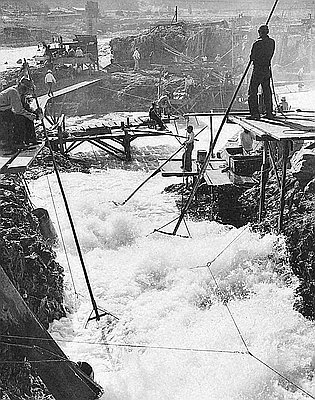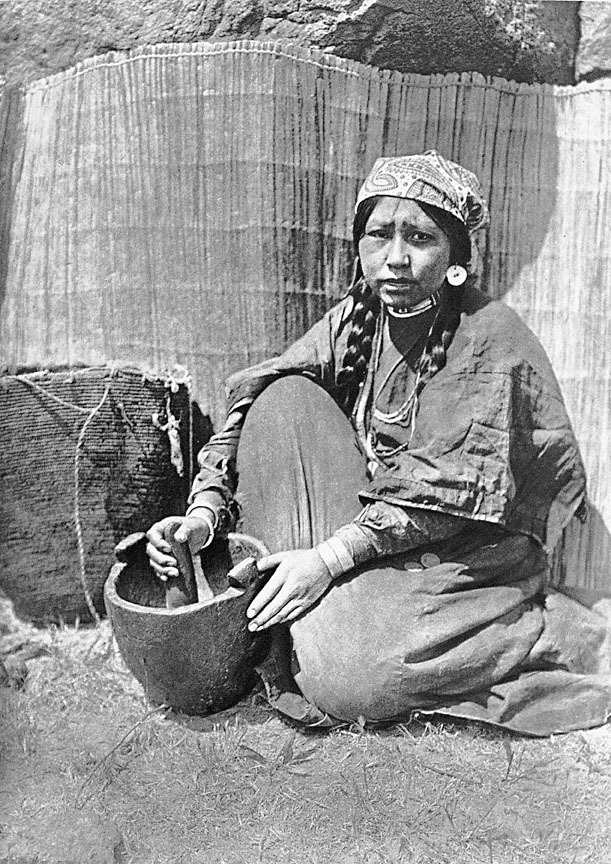- Catalog No. —
- OrHi 67537
- Date —
- 1910
- Era —
- 1881-1920 (Industrialization and Progressive Reform)
- Themes —
- Environment and Natural Resources, Government, Law, and Politics, Native Americans, Women
- Credits —
- Oregon Historical Society
- Regions —
- Columbia River
- Author —
- Edward Curtis
Pounding Fish, Wishham, 1910
This photograph shows a Wishxam (also spelled Wishham or Wishram) woman making pounded salmon near Celilo Falls. It was taken by Edward Curtis in 1910.
The sexual division of labor in pre-contact and early contact Columbia River Indian societies mirrored that of almost all known foraging societies. Men focused on hunting and fishing while women gathered plant foods and prepared the meat and fish. At The Dalles-Celilo fishery in the eastern Columbia Gorge, women would carry salmon a quarter mile or more from the river, using open mesh baskets that they made themselves. After cleaning the fish, they would cut them into sections and hang them to dry in specially designed sheds.
In addition to dried and smoked salmon, women also made pounded salmon. After gutting and beheading the fish, women cut the salmon into strips and put them in the hot sun. When the flesh was soft, they shredded the fish, thoroughly mixed it with roe or berries, then left it out in the sun to dry. After it was dry, they pounded it into a fine powder using a maple mortar and stone pestle (shown in the photograph above), then packed it tight into baskets that they made. This pounded salmon, known as ch'láy in Sahaptin or itk'ilak in Chinookan, could last for years and was considered a great delicacy among the Indians of the region. It was a staple trade item prior to white settlement.
Preparing fish was difficult work, and many early white observers expressed objections to how hard Columbia River Indian women labored. Missionary Henry Perkins, for example, commented in 1838 that Wasco women “have to labor like slaves. Every day we see them out beside their houses, sitting almost naked on the ground, in the wind and the sun, manufacturing large coarse mats, on which to dry and in which to preserve their salmon. They are untiring at it as the Virginia slaves….”
Although many early white observers thought Indian women worked like “slaves,” recent ethnographic research calls into doubt this interpretation of women's roles in Columbia River Indian societies. Anthropologist Lillian Ackerman, for example, argues that among Plateau Indians, “the work of both genders was equally valued.” Although preparation of salmon was hard work, Ackerman points out that “once a woman put her labor into preparing the salmon, it belonged to her; she made the decisions on its use autonomously.” She argues that, rather than being a mark of “slavery,” the work women performed in the preparation of fish enhanced their economic autonomy and social position.
Further Reading:
Ackerman, Lillian A. A Necessary Balance: Gender and Power among Indians of the Columbia Plateau. Norman, Okla., 2003.
Curtis, Edward S. The North American Indian. Volume 8. The Nez Perces, Wallawalla, Umatilla, Cayuse, the Chinookan Tribes. Norwood, Mass., 1911.
Written by Cain Allen, © Oregon Historical Society, 2006.
Related Historical Records
-
Women Dry Salmon at Celilo Village
This photograph shows Warm Springs tribal members Edna David (left) and Stella McKinley (right) drying salmon at Celilo Village. It was taken by an Oregon State Highway Travel …

-
Indians Fish at Celilo Falls
Celilo Falls was an important center for native trade, culture, and ceremony. For at least 11,000 years, tribes throughout the region, and from as far away as the …

-
Chief George Charley's Seining Crew
This photograph shows Chief George Allen Charley (center in vest and white shirt) and his seining crew in Pacific County, Washington, around 1907. Chief Charley was chief of …

